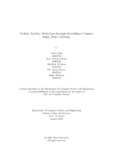| dc.contributor.advisor | Alam, Md. Golam Rabiul | |
| dc.contributor.author | Miah, Parvez | |
| dc.contributor.author | Haque, Abrar Ahbabul | |
| dc.contributor.author | Imran, Abdullah Al | |
| dc.contributor.author | Hassan, MD. Radip | |
| dc.contributor.author | Rahman, Rafiur | |
| dc.date.accessioned | 2023-05-25T10:06:58Z | |
| dc.date.available | 2023-05-25T10:06:58Z | |
| dc.date.copyright | 2023 | |
| dc.date.issued | 2023-01 | |
| dc.identifier.other | ID 19101339 | |
| dc.identifier.other | ID 19301040 | |
| dc.identifier.other | ID 19101482 | |
| dc.identifier.other | ID 19101524 | |
| dc.identifier.other | ID 19101461 | |
| dc.identifier.uri | http://hdl.handle.net/10361/18331 | |
| dc.description | This thesis is submitted in partial fulfillment of the requirements for the degree of Bachelor of Science in Computer Science, 2023. | en_US |
| dc.description | Cataloged from PDF version of thesis. | |
| dc.description | Includes bibliographical references (pages 35-36). | |
| dc.description.abstract | Surveillance camera systems have been implemented in most parts of the world
to combat the rising rate of criminal activities. In the hopes of making public
places safer for everyone, computer vision has also aided in making these systems
more sophisticated but reliable and efficient. However, we are yet to make them
better. While modern systems are able to record incidents, they often do not do
so intelligently in order to make it easier for law reinforcements to respond quickly
enough to aid victims or stop more crimes from occurring. Hence for our thesis
project, we intend to use computer vision on a surveillance system so that it is able
to identify crimes such as physical altercation, harassment, hijacking, snatching,
etc. In this model, an action recognition system will be used, where we will be
using extracted images from video feeds from multiple sources, and all those sources
(cameras) will be centrally connected to a server. The server will be connected
to databases containing information about violent activities. Based on the feeds,
a signal will be sent to the respective system if a particular activity is detected.
This system is mainly based on image processing concepts using different neural
networks like MobileNet-V2, ResNet50, and LSTM to match live images with the
existing trained system. This model will specifically use to detect criminal activities
such as punching, kicking, slapping, and weapon violence, and all these pieces of
information will be previously stored in the database. We have also implemented
Grad-CAM in an effort to apply model explain ability. | en_US |
| dc.description.statementofresponsibility | Parvez Miah | |
| dc.description.statementofresponsibility | Abrar Ahbabul Haque | |
| dc.description.statementofresponsibility | Abdullah Al Imran | |
| dc.description.statementofresponsibility | MD. Radip Hassan | |
| dc.description.statementofresponsibility | Rafiur Rahman | |
| dc.format.extent | 36 pages | |
| dc.language.iso | en | en_US |
| dc.publisher | Brac University | en_US |
| dc.rights | Brac University theses are protected by copyright. They may be viewed from this source for any purpose, but reproduction or distribution in any format is prohibited without written permission. | |
| dc.subject | Deep learning | en_US |
| dc.subject | MobileNet-V2 | en_US |
| dc.subject | ResNet50 | en_US |
| dc.subject | Surveillance camera | en_US |
| dc.subject | Security | en_US |
| dc.subject | Suspicious activity | en_US |
| dc.subject | CNN | en_US |
| dc.subject | LSTM | en_US |
| dc.subject | Grad-CAM | en_US |
| dc.subject.lcsh | Machine learning | |
| dc.subject.lcsh | Cognitive learning theory | |
| dc.title | Violent activity detection through surveillance camera using deep learning | en_US |
| dc.type | Thesis | en_US |
| dc.contributor.department | Department of Computer Science and Engineering, Brac University | |
| dc.description.degree | B. Computer Science | |

